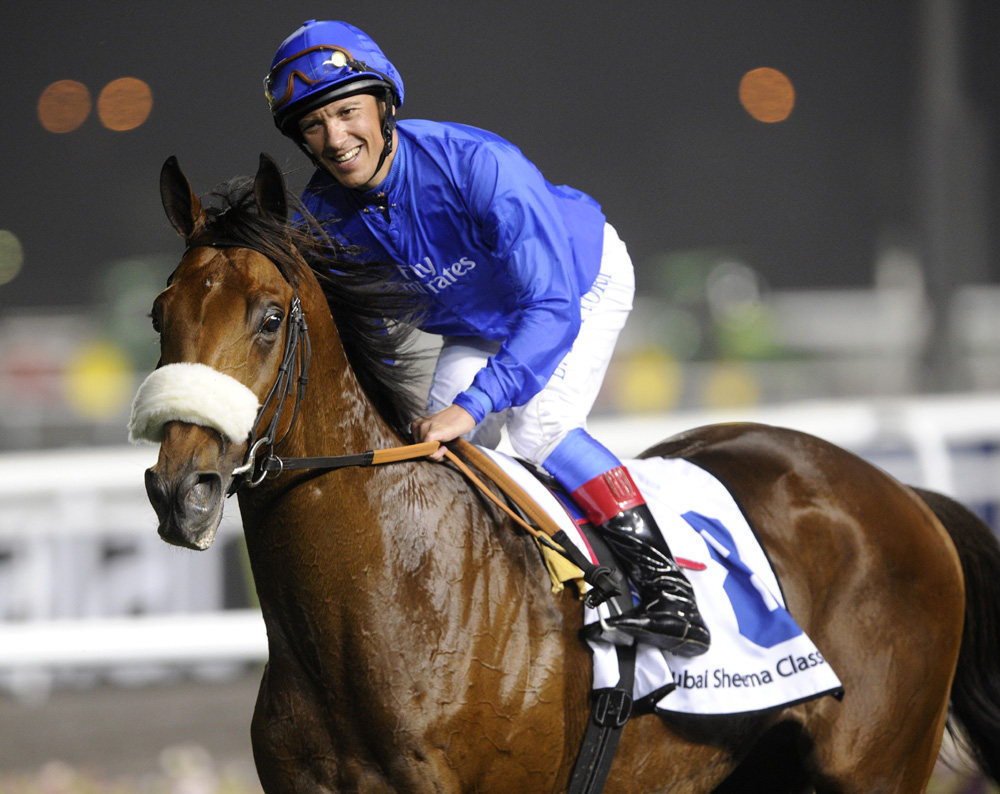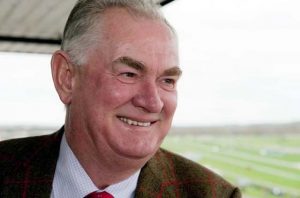At the recent round of breeding stock sales, the dams of Maybe, Canford Cliffs, Treasure Beach, Society Rock and Moonlight Cloud all passed through the ring at Tattersalls. With a Group 1 winner apiece in 2011 and a fashionable covering, each would be a coveted addition to many broodmare bands and they all had another key element in their favour: age.
Sumora, Mrs Marsh, Honorine, High Society and Ventura were nine, ten, 11, 12 and 13; safely within the ‘acceptable’ age range, from a commercial perspective at least.
There is plenty of evidence to suggest that younger mares are a better bet for the breeder – the onset of old age for any species brings with it myriad problems – but is it always a wise choice to favour perceived potential over proven ability?
In the case of the December Sales-topper Sumora, she had it all. Only nine, a Listed winner by one of the modern-day great broodmare sires and a three-parts sister to dual Classic winner Dancing Rain, she has already produced the unbeaten Group 1 winner Maybe and was carrying that filly’s full-sibling by the champion sire Galileo. Enough said. Few of Sumora’s contemporaries can equal her outstanding credentials and those that do will almost certainly be out of reach, except for breeders with the deepest of pockets.
The principal way in which age affects a mare’s value is in the projection of how many foals she may be able to produce in the future. While naturally this depreciates with age, there is value to be found among mares of advancing years and those with a proven production record can be worth taking a chance on with the right management.
As our table below shows, the oldest mare to have foaled a Group 1 winner last season was 24. She is Lord and Lady Lloyd-Webber’s Darara, who has to has to be considered the doyenne of the ‘old mares’ brigade’, having produced Dar Re Mi at 22 and her final foal Rewilding at 24. Now 29, she is reported to be enjoying her retirement and in fine health.
“The remarkable thing about Darara is that still, at her age, her feet are fantastic and she’s absolutely correct,” says Simon Marsh, Manager of the Lloyd-Webbers’ Watership Down Stud.
“We bought her as an 11-year-old carrying to Shirley Heights and she’d already produced a Listed winner. When buying mares, 12-year-olds would be about our upper limit.”
He adds: “Older mares need to be covered each year but the difficult thing about Darara was that she was barren for four years in a row, from 2000 to 2003. We talked to [equine fertility experts] Twink Allen and Huw Neal, and they suggested we flush her Fallopian tubes, which we did and it worked. She then got in foal to Selkirk, then Singspiel and Tiger Hill, but she had only 12 foals in her life.”

Darara’s last foal, the late Rewilding
Spurred on by their success with Darara, Huw Neal, a partner at Newmarket Equine Hospital, subsequently conducted a trial in conjunction with Professor Twink Allen which involved a surgical procedure during which Prostaglandin-E is injected into a mare’s oviduct (Fallopian tubes) to stimulate muscle contractions and aid the mobility of a fertilised egg in its transfer to the uterus.
“Fertility is the main problem for older mares and there are a number of reasons for that,” says Neal. “As mares enter their late teens the quality of their eggs begins to deteriorate and that means conception rates are not as good and established pregnancies can fail.
“The second big issue is that the quality of the uterine lining also deteriorates and that’s associated with a reduction in fertility.
“The nutritive components – the glands – begin to be replaced by fibrous tissue and that deterioration means that it’s harder for a mare to support a pregnancy. Conception weights go down and so do birth weights of the foals.”
During the course of their research, Allen and Neal were able to establish that as mares get older they are more likely to suffer from obstructions in their oviducts caused by protein deposits. Unlike other species, a mare’s fertilised egg sits in the oviduct for five days before reaching the uterus, which it is unable to do without a clear passage.
Neal adds: “It was lucky for us that this method worked with Darara and she was such a success as it encouraged us to carry on. We then did a trial on 15 thoroughbred mares who had histories that suggested possible obstructions and 14 out of 15 conceived during the next breeding season. Up to that point there had been little information about possible obstruction in the oviduct, only speculation.”
Statistics not the whole story
The table of 2011 Group 1 winners (below) represents only a tiny portion of the racing population but is heavily weighted towards the offspring of younger mares. It is a curve echoed by published data on the birth order of foals, and by a 1995 study by Jane Barron, which looked at the effect of a mare’s age and the number of foals she had borne by assessing the Timeform figures of the offspring of 100 mares.
Barron’s findings, published in the Equine Veterinary Journal, showed that the mean Timeform rating of the study group peaked for the offspring of mares aged nine, and for those who had had four foals. As she pointed out, however, “the optimum retirement age for broodmares may increase with the quality of their progeny”.
When weighing up statistics it must be taken into account that the number of older mares still in production, whether through natural reduction or deliberate culling, is much lower than that of their younger counterparts. According to Weatherbys’ records, of 9,826 active broodmares in Britain in 2010, only 448, or 4.6%, were aged 20 or over, with 62% of the broodmare population being aged between five and 12. Of the older mares still in service, there will doubtless be plenty, even among the proven black-type producers, who will be covered by unproven or ‘lesser’ sires, and, as already acknowledged, declining fertility plays its part.
Meta Osborne, a veterinary surgeon who specialises in equine reproduction and runs Ireland’s Tinnakill House stud with her husband Dermot Cantillon, says: “A mare’s fertility typically declines from 15 years onwards and is likely due to a number of factors. These include late first ovulation in the spring, longer intervals between ovulations because follicles develop more slowly in older mares, erratic cycling, increased incidence of ovulation failure, age-related degeneration of uterine architecture and a higher incidence of early embryonic death (EED) in older mares.”
While this may sound daunting, such knowledge has not stopped Osborne and Cantillon investing in and persisting with older mares. One of Tinnakill House’s recent high-flying graduates is Casamento, whose dam Wedding Gift has just turned 19 and is currently carrying his full-sibling. Of the same age is Housa Dancer, whose offspring Bushman and Grand Vent have each won a Group race since she was purchased at Brightwells in 2009 for £7,000.
“There is no magic formula for us, it just seems that there is a huge premium in the sales ring for potential as opposed to results,” says Osborne. “We prefer to buy value in the proven producer and, by definition, they will be the older mares. The bias against them works in terms of getting them at the right price.”
She adds: “I don’t believe in breeding older mares every other year – it can be hard enough to get them in foal as it is and some mares will give themselves a break in any case.
“Expert veterinary intervention in mare reproductive management is probably the most cost-effective part of a breeding operation, especially when you relate it to nomination costs.”
We prefer to buy value in the proven producer and, by definition, they will be the older mares
Even once an older mare has conceived and safely produced a healthy foal, the bias against them doesn’t end there. Charlie Mason, who runs Silfield Bloodstock, which deals principally in buying and selling mares and foals, has seen a shift in attitude towards the stock of veterans.
He says: “People [buyers] have more of a bias against foals out of older mares now. However, I’ve been lucky with older mares in the past and if something came up I’d probably have a nibble, but you do have to think very carefully.
“On the whole I’d probably look at slightly younger mares now and once they get past 16 I like the mares to have a rest every other year, otherwise it can take too much out of them.”
Studies by Kentucky Equine Research (KER) show that mares between the ages of seven and 11 produce foals of a heavier birth-weight than older mares, thus generally making them more desirable at the sales, but lower birth-weight is not just a potential problem with older mares. “Foals born to maiden mares have lower birth-weights than those from multiparous mares,” says Clarissa Brown-Douglas of KER.
However, Simon Marsh believes that the look of the mare’s stock will dictate procedure, saying: “People say you can’t buy out of an older mare but you can buy only what’s in front of you. If a mare’s still producing good-looking creatures, which is what Darara did with her last two foals, then it’s fine to carry on.
“Mares have to be in good health to get in foal and if a mare has not produced a decent runner by the time she’s about 15, the chances are she would be taken out of production anyway.
“We kept persevering with Darara because we desperately wanted a filly and we ended up with a really good one.”
That “good one”, Dar Re Mi, is due to deliver her first foal, by Oasis Dream, in mid-February. Another Group 1 winner carrying to Juddmonte’s great stallion is Gilt Edge Girl, who now resides in a paddock next door to her mother following the recent purchase of her dam Tahara at Tattersalls. Tahara was one of a quartet of 17-year-olds offered for sale in December and, despite her advancing years, she fetched 180,000gns when bought by Badgers Bloodstock for Paul Makin.
“When it comes to a mare’s age it very much depends on who the order is for,” says Badgers Bloodstock’s Grant Pritchard-Gordon, who has been vociferous in his desire to see an upper-age limit set by sales companies when accepting broodmares for auction.
“If I know it’s someone with a good set-up at the stud and experienced people who will ensure the mare is well looked after, I have no problem with buying a 16- or 17-year-old mare.
“I think that Tattersalls in particular has a very good open procedure in place in this regard. They view each horse on a case-by-case basis. In lesser sales around the world I’m not convinced that there’s the same level of care.
“The big problem for me was seeing a 22-year-old barren mare being offered for sale. I hate the thought of old mares being subjected to the stress and strain of a sale. If the time is right and if a mare has an advancing condition, then I’d be very much in favour of putting her down humanely rather than sending her to a sale where you have no control over who buys her.
“In the case of Tahara, she has a great production record, a fashionable covering [Acclamation] and she looked incredibly young for her age.”
Noteworthy mares
Along with the aforementioned Darara, there are a number of mares worthy of mention for having produced a Group 1 winner in their twilight years, and these include Somethingroyal, who foaled Secretariat when she was 18, Selection Board, who was 19 when Ouija Board was born, and the great Urban Sea, who produced Sea The Stars as a 17-year-old. Her final foal, Born To Sea, was delivered when Urban Sea was 20 and he may yet add more glory to his outstanding family’s record.
Tony Morris’s plentiful pedigree notes on Derby winners reveal that 16 winners of the Blue Riband have emanated from mares aged between 18 and 25, with Horatia having bred two at an advanced age: the 1799 winner Archduke when she was 18 and his full-brother Paris, in 1806, at the grand age of 25.
While breeders with a long-term aim will understandably opt for the younger producer, clearly there will always be a nucleus of older mares whose genetic constitution enables them to rebuff the advancing years and continue to nurture a good foal. And with advances in veterinary science, aided by the likes of Huw Neal and Twink Allen, that number is likely only to increase.
Group/Grade 1 winners in 2011 from older mares:
Gr.1 winner/Dam/Age when foaled
Rewilding (GB), Darara, 24
Cozi Rosie (USA), Felidia, 22
Flat Out (USA), Cresta Lil, 20
Playing God (AUS), Dolly Will Do, 18
Rock ‘N’ Pop (AUS), Popsy, 18
Descarado (NZ), Karamea Lady, 18
What A Winter (SAF), Waseela, 18
Jukebox Jury (IRE), Mare Aux Fees, 18
Acclamation (USA), Winning In Style, 18
Cape Blanco (IRE), Laurel Delight, 17
Covenant (SAF), Secret Pact, 17
Galikova (FR), Born Gold, 17
St Nicholas Abbey (IRE), Leaping Water, 17




